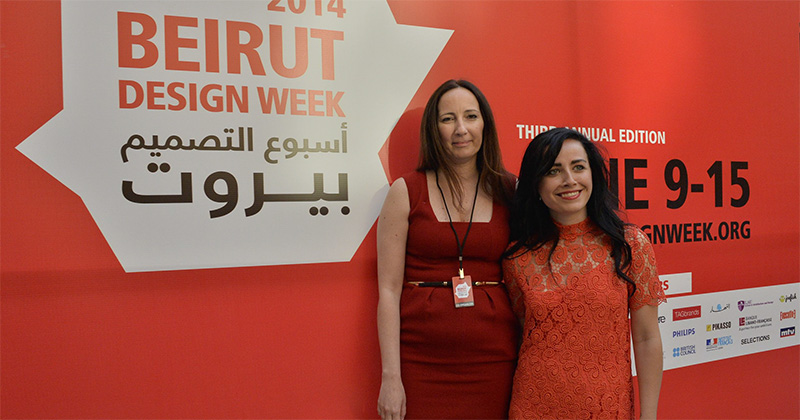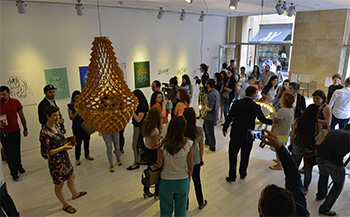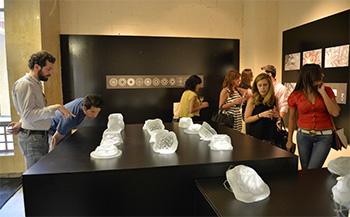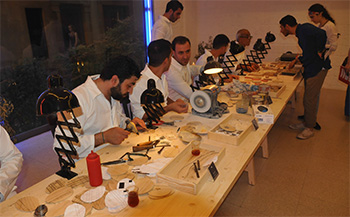Beirut Design Research Center Launches Annual Design Week in Lebanon
The MENA Design Research Centre is a non-profit organisation based in Beirut. The idea behind it is to be able to have a discourse or a platform to look into design in the Middle East and to understand the role that design research can play in terms of education, social impact, a creative economy and entrepreneurship.
Interview with Doreen Toutikian, Co-Founder/Director of MENA Design Research Center, and Maya Karanouh, Co-Founder/Chair of MENA Design Research Center and CEO/Co-Founder of TAGbrands

Thank you for talking to Marcopolis today about Beirut Design Week, which ran from June 9th to June 15th, and about the importance of design and the creative sector in the Lebanese economy and the regional cultural identity. Please tell us a bit about your company Maya, TAGBrands, and then about the NGO you and Doreen cofounded the MENA Design Research.
TAGBrands is a branding and design consultancy that we opened five years ago. It is a regional company. We brand some of the top clients in Lebanon. We usually take clients through a four-step process. Firstly, we explore the competition in the market and then we re-identify and reposition our clients. We then define a strategy and create the concept, mood, and final identity for them. Branding is not something that you do just once; it has to be continual in order to build up the brand. Therefore, most of our clients go through this process continually, and wherever they are in their brand lifecycle when they come to us, we move them on from there. We align business strategies to enhance brand development and deliver communications that ensure strong brand value and ROI.
Can you give us some names of your clients?
We recently rebranded the Banque du Liban, which we are very proud of because it is an iconic heritage brand. We also work with Bank Audi, IPT, Debbane Saikali Group, M1 Group, Taanayel Les Fermes and L’Oreal. We have recently worked with Bar Tartine, which is a restaurant that has become very successful and we are very happy with it. We work with a whole variety of clients, which is very interesting because we learn about all the different kinds of industries in the market.
If you look at the design and creative sector over the past twenty years, you will see that it has basically built up the entire MENA region in terms of advertising and creative agencies.
Branding can include anything from logo design to written statements; can you tell us more about the branding process?
Yes, I always describe branding as a process where you have to think about a company as if it were a human being i.e. something that talks, thinks, and looks like something. Branding is not something superficial. The branding also has to follow the business strategy. Sometimes clients come to me without a business strategy for the next few years and I have to tell them that in that case we cannot brand their company and we won´t take on the project. It is very important to have a business strategy because if you do not have a business strategy, you shouldn´t spend money on branding, as it will be superficial.
Tell us a bit about MENA Design Research Centre.
The MENA Design Research Centre is a non-profit organisation based in Beirut. The idea behind it is to be able to have a discourse or a platform to look into design in the Middle East and to understand the role that design research can play in terms of education, social impact, a creative economy and entrepreneurship.
When I was a student, I decided to study my Master’s degree abroad and I realised that there was so much more awareness about what was happening in the field of design in the rest of the world. The problem was that many of our young Lebanese designers would go and study abroad where they would see that the design industry was more developed and they would eventually leave Lebanon. Brain drain was one of the issues that really bothered me the most.
When I decided to return to Lebanon, I really wanted to create a centre that would bring together everything that we are learning in all disciplines of design and that would show the value of design.
We really have great potential here in Lebanon in terms of human resources in the design industry. There are many creative projects happening in Lebanon and I think that we should really showcase them. I came back to Lebanon in October 2010 to begin this project. Maya and I cofounded the MENA Design Research Centre and TAGbrands, incubated the MENA Design Research Centre and to help us push ourselves to accomplish many of our large projects, particularly Beirut Design Week. 
Can you tell me a bit more about Beirut Design Week?
Beirut Design Week was almost a direct result of the Desmeem project because we wanted to have an exhibition that was designed to have a social impact. However, we did not want it to be just another exhibition about NGOs doing something for social and environmental purposes. We wanted to get the big crowds to come to this event but we were not sure how to do that, so we decided that, apart from our design students, we needed to get more designers to exhibit. We contacted all of the designers that we know of in Lebanon and we asked them if they would like to be part of the event that we were organising. Luckily, we got a lot of support from the design community and the event was held at the Ministry of Tourism.
This is going to be the third year running, congratulations! Tell us what concepts are involved when heading a design related business. Amongst other specialties Beirut Design Week will bring together Lebanese architects, fashion designers, textiles manufacturers and a whole other variety of creative experts.
There is definitely a much broader concept to design than what the general public might expect. The main reason for this is that most people only see the end result of design and so they think of design as being designer clothing and fashion. However, when you study design over a number of years, and especially when you study a number of disciplines, you realise that there is a whole process involved that is similar for all designers in all disciplines from fashion to architecture. This process is a kind of creative problem solving activity that brings together the whole idea of design. This becomes very apparent with our Design Week because as you said, there are many architects, fashion designers, jewellery designers etc. involved in the event and sometimes you find that artists have combined different areas of design in their work and so you can see how broad the concept of design can become. It bothers me when people assume that design is just fashion design. Of course, fashion is a very important part of Lebanese design but there is so much more that needs to be showcased.
Therefore, in part this is a learning process for the public. What are your thoughts about the range of design that exists in Beirut?
If you look at what has happened abroad, design has been taken out of its small niche and is now multi-disciplinary. In many countries abroad, municipalities are now hiring designers to help them with social and community projects; for example, they go into schools and help solve problems with school canteens. There are many projects where designers’ skills can help solve problems in the community and so municipal governments are hiring all sorts of designers. With the Beirut Design Week, we are trying to create a kind of platform to show the community and the government here that the design sector is an area that they should begin to invest in. 
One would imagine that corporate sponsorship has increased remarkably since the first Beirut Design Week. Having said that, would you say that the Beirut business community is helping sufficiently? Furthermore, do you feel you have enough support from the relevant government bodies?
Well, you can always do with more support! However, as you said, corporate sponsorship has grown substantially. This year for the first time, we have a gold sponsor, who is a bank, and for us this is definitely a big step. Now people see the event as credible because this is now the third year of the Design Week. In terms of government support, of course, we would always like to have more support but you have to understand that as much as this is a learning process for the public regarding design, it is probably an even more strenuous learning process for the government. We believe it is just a matter of time for them to see the value of design. Once the government sees the benefits of working with the design community then I think that of course they will want to support us further.
How has the design and creative sector grown in Lebanon over the last decade? How important is the sector for the Lebanese economy?
This is a very important issue, and it is one of the main issues that we want to highlight to the government. The government’s focus over the past few years has been the Tech sector, which of course is a very important and valued sector here in Lebanon. However, if you look at the design and creative sector over the past twenty years, you will see that it has basically built up the entire MENA region in terms of advertising and creative agencies. It is a huge industry and the Lebanese creative sector has built up the entire regional advertising and creative sector. We have to highlight this to the government so that they can understand how necessary it is to invest in our creative sector. We have to invest in helping build more diverse programs in our creative university programming. If we do not invest, we are going to experience more brain drain and other issues. If you look at England, they have invested a lot in their creative sector and they are seeing a return on that investment. However, here the government is not looking at investing in our creative sector. It is a key problem that we have. We try to highlight this a lot through Beirut Design Week.
We believe design plays an important role in the creative economy. We think of it as design equity; if there are more design activities going on here, then Lebanon can attract more international investment. It is not so much about the fashion designers, jewellery designers and graphic designers etc. fuelling the economy as it is about them encouraging more investment in the creative industry in Lebanon.
Throughout our work, we try to focus on creating an economic creative hub in Beirut. We are focusing on branding Beirut as the Design Capital of the Middle East. This is the main focus of the MENA Design Research Centre. Unlike Dubai, which imports all of its creative and academic talent because it has the money to do so, our talents are home grown and we have all of the academic institutions set up here. Essentially, we have the ecosystem to be a design capital, which is fantastic. We are trying to build our reputation on a mass level. We need to come together as a community so that we can have one voice and be heard. 
Do you see a future where a lot of GCC clients and European clients come here to contract Beirut creatives?
We see a lot of collaboration in the future. This year was the first time that a group from the Dutch Design Week have come to expose their work. There will be a lot of collaboration with other Design Weeks, such as Paris Design Week, Milan Design week, London Design Festival, New York Design Week etc. We already have many collaborations, but we will see many new collaborations in the future.
Beirut Design Week is not organised by a company whose main aim is to sell more; we are a non-profit organisation that also looks into the role of design in education and we are involving all of the universities. We think that it is important to fill this week with knowledge and skills sharing. This is the basis for why we have a lot of workshops, documentaries and talks. The workshops and talks are there to bridge the gap between what exists in the design industry and design education abroad, and what we have here. These workshops are based on our own input and input from designers all over the region, especially in Lebanon. We also take input from the universities. The designers give their own workshops to share their skills and their spaces so that they can get more people involved in this process. There are many workshops for people to develop new skills and to learn more about design as a whole. They are not specifically for students; anyone who is interested in design can attend them.
You even have a dinner party to celebrate the event!
The designer dinner is something that we decided to do so that designers from abroad can meet our local designers in a more intimate space to find out what is going on here and abroad. It is a nice relaxed way to have a conversation about design.
There are more than 100 events going on during Beirut Design Week and even some programs for kids, so we hope that people download the program and attend the event.